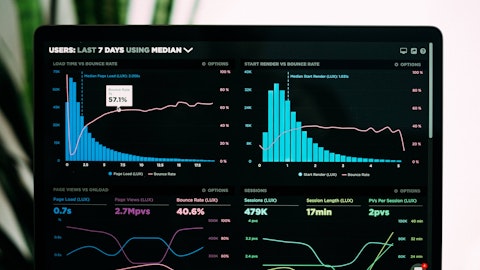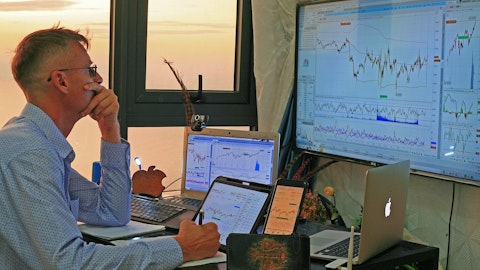But there are many other customers other than the ones that can benefit from a fully integrated, tremendous infrastructure to bring out to, not every customer has the number of wells and the type of fields that require that type of setup. And that would benefit from that type of capability. There are plenty of customers who need the breadth of services that we offer. So that’s where we’re aligned. And that’s where we’re set up. That’s where we have our historical relationships. And I expect for the time being, that’s where we’ll focus as it relates to pressure pumping.
Derek Podhaizer: Got it, that makes sense. And then just a follow-up from me, maybe just talking about the competitive landscape in frac among those, those smaller players, the privates that we don’t get great insight to manage those Tier 2 diesel players, I’m not sure if you come across them when you bid work or just see them out in the field? But there’s been anecdotes of bankruptcies and laying down equipment, but just any insight that you guys can provide from what you’ve seen would be helpful.
Ben Palmer: Right. Not a whole lot specific. Obviously, we see them from time to time and hear that sometimes when we miss opportunities, it might be to one of those smaller players. Obviously, the pressure pumping equipment to upgrade and continue to invest in that equipment is expensive. And it’s not everybody can afford to do that. So hopefully, maybe we’ll have a shakeout in that regard, maybe that part of the market will further improve. And we’re certainly set up to take advantage of that. When the market tightened in the first and second quarter of 2023, we had tremendous financial results within pressure pumping, and obviously, the market loosened up a bit. We think some of the smaller players, as you’re indicating, I think it will be difficult, a challenge, as it always is, for them to be able to expand, so hopefully that market will improve a bit.
And certainly, overall in North America, we have a relatively smaller market share in pressure pumping, but within the regions and the particular customers that we focus on, again, that don’t need all of these massive infrastructure. We’re pretty well positioned and do well in that market.
Derek Podhaizer: Got it. Appreciate all the color. I’ll turn it back.
Ben Palmer: Sure, Ben. Thank you.
Operator: [Operator Instructions] Your next question comes from the line of Stephen Gengaro with Stifel. Please go ahead.
Stephen Gengaro: Thanks. I just wanted to follow-up. Thanks. We’ve heard a lot about pricing bifurcation in the market between low emission assets and older assets and also difference between spot pricing for pressure pumping versus contracted or committed arrangements. Can you comment on that a little?
Ben Palmer: It’s getting more and more complicated. The more fully integrated, whatever you want to call it, some of our larger peers that have all this infrastructure to be able to bring to a well site, they’re obviously getting paid something for that. But that requires an additional investment, right. So their investment, all things being equal, is a lot per fleet, if you will, is a lot higher than our investment, right. I think to talk about pricing, because of those various aspects that you feel back the various services that are being offered. Again, we have a number of services, some of which work from time to time with our pressure pumping fleet. And we watch our pressure pumping service line. We monitor each of the service lines individually, there is some opportunity to bundle services.
But that’s not something that we focus on per se, right, we try to be the best we can be at a particular service we’re trying to execute. Clearly it seems that some of the very large E&Ps appreciate. Or for us, that’s the word, appreciate, we’ll contract, we’ll look for some of the service providers that do have a multitude of different services to bring. But there are a lot of customers who still like to unbundle customers love to have competitors, they’re not going to give all their business to one service company, it’s never happened, and I don’t believe it’s going to happen in the future. So we’re continuing to improve our fleet. We’re following our roadmap. It’s certainly adjustable, but we have a roadmap that says, as our equipment wears out, we’re going to invest and buy new equipment, and it certainly will be equipment that is newer has additional capabilities, where our significant percentage of our fleet today can burn natural gas.
And that is appealing to some of our customers, not every one of our customers. And those decisions that we’re making are, they’re financial decisions, they’re not decisions just to say we want to do whatever it takes to have x percentage of our fleet have a particular characteristic. A point in time, we’re letting the market and our customers and the demand dictate when we make those investments. So we’re moving that along. Obviously, the ordering of this new Tier 4 fleet moves us along that path. Again, that’s consistent with our roadmap. And like I said, it is flexible in terms of the exact points that we take delivery and pay for that type of equipment, but we’re executing on that plan for the long-term, and we’re improving our fleet as we do that.
Stephen Gengaro: Great. Now that’s good color. Thank you.
Ben Palmer: Sure. Thank you, Steve.
Operator: Your next question comes from the line of Derek Podhaizer with Barclays. Please go ahead.
Derek Podhaizer: Hey, guys. I just wanted to ask about your exposure to a couple of basins, primarily the Haynesville, MidCon and Eagle Ford. I mean, these basins were the ones that came under the most pressure, as gas started to capitulate and gas has been pretty lethargic here, pushed out to 2025. So can you maybe take some time for those three basins and give us a sense of what you’re seeing as far as activity and customer with conversations?
Ben Palmer: Yeah. You said three basins, Haynesville –
Derek Podhaizer: Haynesville, MidCon, Eagle Ford.




